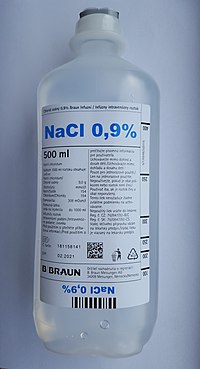
Photo from wikipedia
Objective:Evaluate the dose-response relationship between intraoperative fluid administration and postoperative outcomes in a large cohort of surgical patients. Background:Healthy humans may live in a state of fluid responsiveness without the… Click to show full abstract
Objective:Evaluate the dose-response relationship between intraoperative fluid administration and postoperative outcomes in a large cohort of surgical patients. Background:Healthy humans may live in a state of fluid responsiveness without the need for fluid supplementation. Goal-directed protocols driven by such measures are limited in their ability to define the optimal fluid state during surgery. Methods:This analysis of data on file included 92,094 adult patients undergoing noncardiac surgery with endotracheal intubation between 2007 and 2014 at an academic tertiary care hospital and two affiliated community hospitals. The primary exposure variable was total intraoperative volume of crystalloid and colloid administered. The primary outcome was 30-day survival. Secondary outcomes were respiratory complications within three postoperative days (pulmonary edema, reintubation, pneumonia, or respiratory failure) and acute kidney injury. Exploratory outcomes were postoperative length of stay and total cost of care. Our models were adjusted for patient-, procedure-, and anesthesia-related factors. Results:A U-shaped association was observed between the volume of fluid administered intraoperatively and 30-day mortality, costs, and postoperative length of stay. Liberal fluid volumes (highest quintile of fluid administration practice) were significantly associated with respiratory complications whereas both liberal and restrictive (lowest quintile) volumes were significantly associated with acute kidney injury. Moderately restrictive volumes (second quintile) were consistently associated with optimal postoperative outcomes and were characterized by volumes approximately 40% less than traditional textbook estimates: infusion rates of approximately 6–7 mL/kg/hr or 1 L of fluid for a 3-hour case. Conclusions:Intraoperative fluid dosing at the liberal and restrictive margins of observed practice is associated with increased morbidity, mortality, cost, and length of stay.
Journal Title: Annals of Surgery
Year Published: 2018
Link to full text (if available)
Share on Social Media: Sign Up to like & get
recommendations!